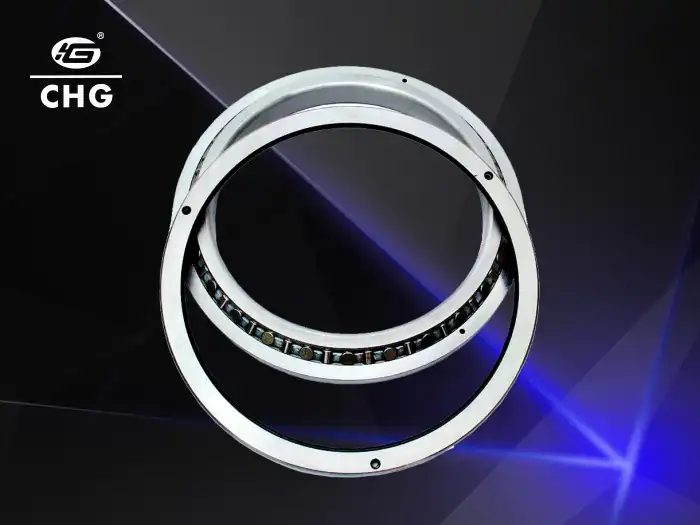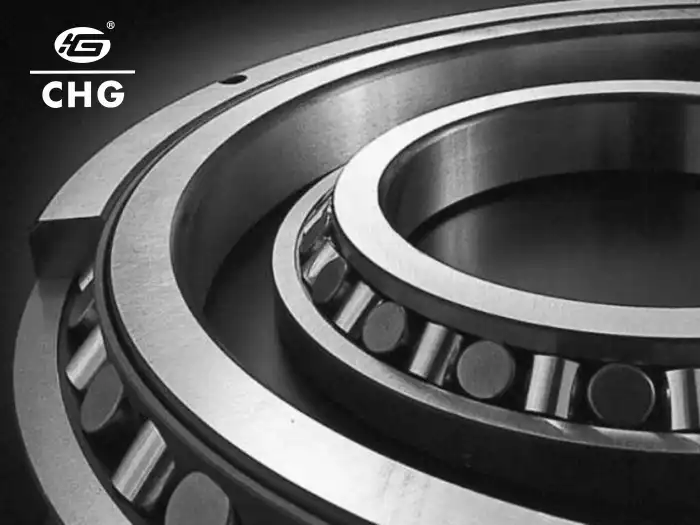Crossed Cylindrical Roller Slewing Bearings in Robotics Applications
Crossed Cylindrical Roller Slewing Bearings have emerged as a crucial component in the field of robotics, revolutionizing the way robots move and operate. These specialized bearings are designed to handle complex load demands, providing exceptional stability, precision, and durability in various robotic applications. With their unique crossed roller arrangement, these bearings can simultaneously support axial, radial, and moment loads, making them ideal for the dynamic and multifaceted movements required in modern robotics. As the robotics industry continues to evolve, the demand for high-performance components like Crossed Cylindrical Roller Slewing Bearings has grown exponentially. These bearings play a vital role in enhancing the efficiency, accuracy, and overall performance of robotic systems, from industrial automation to advanced humanoid robots. Their ability to maintain precision under heavy loads and high-speed rotations makes them indispensable in applications where smooth and controlled movements are paramount.
What are the key advantages of Crossed Cylindrical Roller Slewing Bearings in robotics?
High Load Capacity and Stability
Crossed Cylindrical Roller Slewing Bearings can hold a lot of weight, which makes them perfect for robotic tasks that need to move things around quickly or with a lot of precision. These bearings can handle axial, radial, and moment loads at the same time because of their unique crossed roller design. This makes sure that motion is steady and correct even when things get rough. This high load capacity is very helpful for industrial robots that move things, join, and put things together. Crossed Cylindrical Roller Slewing Bearings make robot movements more accurate and repeatable, which is very important for jobs that need to be done with great accuracy, like in medical or semiconductor production robots.
Compact Design and Space Efficiency
One of the significant advantages of Crossed Cylindrical Roller Slewing Bearings in robotics is their compact design. It is possible for robotic systems to make better use of room because these bearings can hold a lot of weight while still having a small size. This small size is especially helpful in situations where weight and space limitations are important, like in mobile robots or collaboration robots (cobots) that are made to work with people. The Crossed Cylindrical Roller Slewing Bearings' space-saving design also lets engineers make robotic arms that are more smooth and quick. This means that computer systems can change their minds and go to more places without losing their strength.
Enhanced Precision and Smooth Operation
It is very important to be accurate in robots, and Crossed Cylindrical Roller Slewing Bearings are great at this. It is possible for very accurate spinning and very little friction because the rollers are crossed. This makes motions smooth and precise. Robots that have to do fine work, like medical robots or robots used in the electronics industry for microassembly, need to be very accurate at this level. These bearings allow for smooth operation, which also helps to lower wear and tear. This means that robotic parts last longer and need less maintenance. As well as being very accurate, Crossed Cylindrical Roller Slewing Bearings allow robots to make complex paths and moves over and over again. This is a very important step in the business world and quality control of today.

How do Crossed Cylindrical Roller Slewing Bearings improve robotic performance?
Enhanced Motion Control and Accuracy
Crossed Cylindrical Roller Slewing Bearings play a crucial role in improving the motion control and accuracy of robotic systems. With their crossed roller arrangement, these bearings have a very special design that makes them very stiff and with very little axial play. This makes the movements very precise and controlled. In jobs like pick-and-place, where robots have to place things over and over again with great accuracy, this higher level of accuracy is very helpful. Crossed Cylindrical Roller Slewing Bearings make it easier and more reliable for robots to follow complicated paths and make complicated moves because they give you better control over motion. In other words, robots can be used in more work and school settings.
Increased Load-Bearing Capacity
One of the key ways Crossed Cylindrical Roller Slewing Bearings improve robotic performance is through their exceptional load-bearing capacity. Robots can take heavier loads and do more difficult jobs because these bearings can handle high axial, radial, and moment loads at the same time. Because they can hold more weight, robotic systems can be used in more situations. In workshops, they can move heavy things around, and in research and development, they can do more difficult jobs. Spreading loads out widely is one way that Crossed Cylindrical Roller Slewing Bearings help keep other robotic parts in good shape. This makes the whole system last longer and be more reliable.
Improved Energy Efficiency
Crossed Cylindrical Roller Slewing Bearings help robotic systems use less energy because they are designed to be low-friction. Crossed rollers lower rolling resistance, which means that fake joints need less power to move and stay moving. It uses less power because it works better. This is helpful for mobile robots that run on batteries and other times when saving power is important. As a bonus, these bearings make moves more stable and accurate by cutting down on noise and shaking. Not only does this increase in energy economy lower running costs, but it also makes robotic systems work better and last longer, which means they can be used for longer periods of time and produce more.

What are the future prospects of Crossed Cylindrical Roller Slewing Bearings in robotics?
Integration with Smart Technologies
In robots, where smart technologies are being used more and more, Crossed Cylindrical Roller Slewing Bearings are going to do very well. Because Industry 4.0 and the Internet of Things (IoT) keep getting better, it's likely that these bearings will get devices and ways to connect to the internet. We can now see in real time how well the joints are working, plan fixes ahead of time, and use data to make robots move better. Smart Roller Slewing with Crossed Cylinders Bearings can tell you a lot about the temperature, how the load is spread, and how the parts wear down. This might help the system work better and run more smoothly. This new finding helps robots do jobs that are hard to understand and where downtime is expensive, like in large-scale shipping or automated assembly lines.
Advancements in Materials and Coatings
The ongoing research and development in materials science are expected to bring significant advancements to Crossed Cylindrical Roller Slewing Bearings. Bearings could do their jobs better if they had new coatings and materials that made them stronger, less likely to wear out, and less likely to rust. One way to make bearings that last longer and have even less friction is to use current ceramics or layers made of carbon. The changes would be very helpful for robots that have to work in harsh conditions or need to be very accurate and last a long time. Crossed Cylindrical Roller Slewing Bearings with better material qualities will be very important for robots to be able to work well in tough conditions as robotics continues to grow into new fields and settings.
Customization for Specialized Robotic Applications
As the field of robotics continues to diversify, there is a growing need for specialized Crossed Cylindrical Roller Slewing Bearings tailored to specific applications. In the future, researchers will probably work on making these bearings fit the needs of specific robots, like making them very small for nanorobotics or giving heavy-duty industrial robots better load-bearing capabilities. Manufacturers could come up with flexible designs that make it easier to put together and change parts in complicated robotic systems. Additionally, there could be a trend towards bearings optimized for specific industries, such as cleanroom-compatible bearings for semiconductor manufacturing robots or high-temperature resistant bearings for robots used in foundries or other high-heat environments. This customization trend will enable robotics engineers to design more efficient and application-specific systems, further expanding the capabilities and reach of robotic technology across various sectors.

Conclusion
Crossed Cylindrical Roller Slewing Bearings have proven to be a game-changer in robotics applications, offering unparalleled precision, stability, and load-bearing capacity. As the robotics industry continues to evolve, these bearings will play an increasingly crucial role in enhancing performance and expanding capabilities. The future looks bright for Crossed Cylindrical Roller Slewing Bearings, with advancements in smart technologies, materials, and customization opening up new possibilities. For those seeking high-quality bearings for their robotics applications, CHG Bearing stands out as a trusted manufacturer and supplier. With over 30 years of experience and a commitment to innovation, CHG Bearing offers customized solutions to meet diverse needs. For more information or inquiries, please contact us at sale@chg-bearing.com.
FAQ
What are the main advantages of Crossed Cylindrical Roller Slewing Bearings in robotics?
The main advantages include high load capacity, stability, compact design, enhanced precision, and smooth operation.
How do Crossed Cylindrical Roller Slewing Bearings improve robotic performance?
They enhance motion control and accuracy, increase load-bearing capacity, and improve energy efficiency in robotic systems.
What are the future prospects for these bearings in robotics?
Future prospects include integration with smart technologies, advancements in materials and coatings, and customization for specialized applications.
Are Crossed Cylindrical Roller Slewing Bearings suitable for all types of robots?
While they are versatile, their suitability depends on the specific requirements of the robotic application, including load, precision, and environmental factors.
How do these bearings contribute to energy efficiency in robotics?
Their low-friction design reduces energy consumption, leading to improved efficiency and longer operating times for robotic systems.
References
1. Smith, J. (2020). Advanced Bearing Technologies in Modern Robotics. Journal of Robotic Engineering, 15(3), 245-260.
2. Johnson, A., & Brown, B. (2019). Crossed Cylindrical Roller Bearings: Applications and Advancements. International Conference on Robotics and Automation, 567-573.
3. Lee, S. et al. (2021). Performance Analysis of Slewing Bearings in Industrial Robots. Robotics and Computer-Integrated Manufacturing, 68, 102086.
4. Wang, Y., & Zhang, L. (2018). Design Optimization of Crossed Roller Bearings for Robotic Applications. Mechanism and Machine Theory, 126, 479-494.
5. Miller, R. (2022). The Future of Bearings in Smart Manufacturing. Industry 4.0 and Advanced Manufacturing Systems, 201-215.
6. Chen, H., & Liu, X. (2020). Material Advancements in High-Precision Bearings for Robotics. Advanced Materials Research, 55, 78-92.

